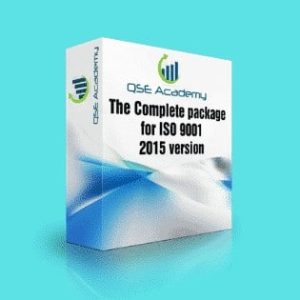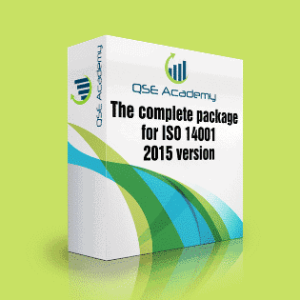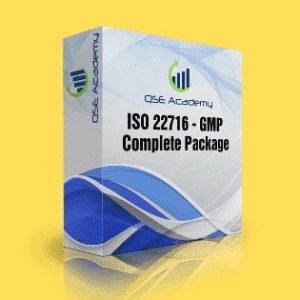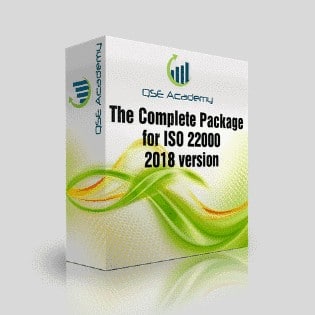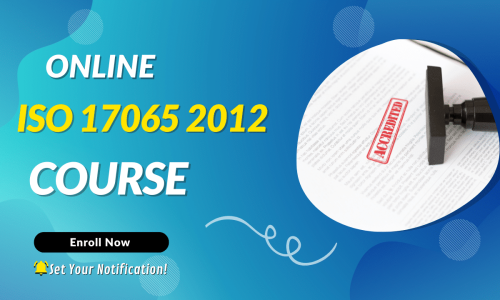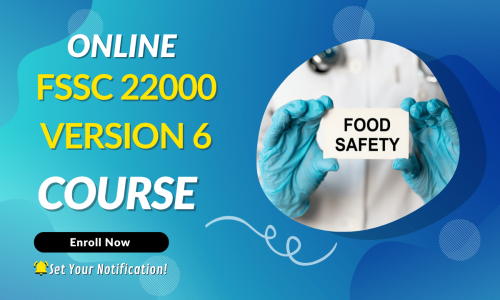Benefits and Importance of Implementing FSSC 22000 Version 6
Last Updated on October 13, 2025 by Hafsa J.
Benefits and Importance of Implementing FSSC 22000 Version 6
Let’s be honest—when a new version of a food safety standard comes out, most people roll their eyes and think, “Great… more paperwork.”
I get it. I’ve worked with food businesses across manufacturing, packaging, and distribution for over a decade, and I’ve helped teams transition through more standard updates than I can count. Some were minor. Some were frustrating. But FSSC 22000 Version 6? This one actually matters.
It’s not just a checklist refresh—it’s a real shift in how we think about food safety systems. Version 6 brings deeper accountability, more focus on food safety culture, better integration with sustainability, and smarter ways to prevent risk. And here’s what I’ve noticed: the companies that lean into this change early are the ones that see the biggest benefits.
In this article, I’m breaking down:
-
What’s new in Version 6—and why it’s worth your attention
-
How it helps your team, your brand, and your bottom line
-
And what I’ve seen first-hand from companies already using it to raise the bar
So if you’re wondering whether the upgrade is worth it, or just trying to make sense of where to start, you’re in the right place.
Let’s walk through it together.
What Makes Version 6 Different from Previous FSSC Versions?
If you’re already certified to FSSC 22000, you might be asking, “Is Version 6 really that different?”
Short answer? Yes. And it’s not just a few extra checkboxes—it’s a smarter, more forward-thinking version of the standard.
Here’s what’s changed—and why it matters.
Food Safety Culture Is Front and Center
Version 6 doesn’t just mention culture—it requires you to prove it. That means demonstrating leadership engagement, employee awareness, and real activities that promote food safety behavior across your entire team.
In practice:
One client started tracking participation in monthly food safety talks and added it to their KPIs. The impact on audit confidence—and team accountability—was immediate.
Equipment Management Requirements Got a Serious Upgrade
The new version emphasizes hygienic design, equipment validation, and preventive maintenance—not just reacting when something breaks down.
Why this matters:
It forces businesses to think proactively. In one case, a processor we worked with updated their equipment specs and caught a contamination risk before it turned into a recall.
Food Loss and Waste Is Now a Compliance Topic
Yes—sustainability is officially part of food safety. You’ll need to measure and manage food loss and waste in your operation, and show continuous improvement.
It’s no longer a “nice to have”—it’s baked into the standard.
Alignment with the Latest GFSI Benchmarks
Version 6 was updated to meet GFSI’s newest requirements, which means it keeps your certification valid and globally recognized.
If your buyers rely on GFSI-approved standards (and most do), upgrading is non-negotiable.
Pro Tip
Don’t treat Version 6 as “just an update.” Treat it like an opportunity to re-evaluate your system, clean up outdated processes, and engage your team in a more meaningful way. It’s more work—but it delivers more value.
Why Version 6 Matters for Food Safety Management Systems
If you’ve worked in food safety for any length of time, you know the goal isn’t just passing an audit. It’s building a system that actually works—every day, with real people, under real pressure.
That’s exactly why Version 6 matters.
It’s designed to take your food safety management system (FSMS) from “compliant” to resilient, proactive, and culture-driven.
It Pushes Risk-Based Thinking Further
Version 6 takes the risk-based approach in ISO 22000 and strengthens it. You’re expected to go beyond identifying hazards—you now need to show how you actively control them across every part of your operation.
Real example:
One facility we worked with used the updated risk approach to catch a supplier issue before it became a major food fraud incident. That kind of foresight saves more than just money—it protects your brand.
It Brings Leadership and Culture into the FSMS
Food safety isn’t just a QA department job anymore. Version 6 asks, How is leadership involved? How do employees at all levels engage with food safety goals?
This creates a system that’s not just technical—it’s lived out across your organization.
From the field:
A packaging company introduced safety shout-outs in team meetings and saw participation in food safety improvements skyrocket in just a few months.
It Strengthens Traceability, Preparedness, and Control
From allergen validation to recall readiness, Version 6 expects more clarity and evidence that your system works under pressure. That means:
-
Tighter traceability
-
Stronger supplier control
-
More robust verification records
And when things go wrong—which they eventually will—you’ll be better prepared to respond quickly and effectively.
Pro Tip
Treat your FSMS like a living system—not a binder on a shelf. Version 6 supports this mindset by requiring engagement, metrics, and active leadership, not just documentation.
Operational Benefits of Implementing FSSC 22000 Version 6
Let’s step away from policy and theory for a second—because here’s the part your team, your floor supervisors, and your operations manager really care about:
How does Version 6 actually help us run better day to day?
The good news?
When implemented with intention, Version 6 makes food safety systems smoother, cleaner, and more efficient across the board.
Better Process Control, Less Chaos
By refining your hazard analysis, validation methods, and PRPs (Prerequisite Programs), Version 6 forces you to tighten the bolts on how your processes run.
That means:
-
Fewer deviations
-
Fewer last-minute fixes
-
More predictability in daily operations
Real example:
One of our clients—a frozen meals facility—used the Version 6 update as a chance to streamline their sanitation process. Not only did they reduce downtime, but post-audit corrective actions dropped by nearly half.
Cleaner, More Usable Documentation
Version 6 encourages lean, purpose-driven documentation. You’re not just documenting to satisfy an auditor—you’re creating tools that help your people work better.
Why that matters:
When your SOPs are readable, your team can follow them. And when they follow them, your system works.
Stronger Supplier and Internal Audit Programs
The new emphasis on food fraud, traceability, and equipment validation naturally sharpens how you manage suppliers and conduct internal audits.
Your teams become more proactive.
Your audits become more useful.
And you uncover small issues before they become costly problems.
Fewer Surprises During External Audits
Because you’ve strengthened your systems from the inside, external audits feel less like a fire drill and more like confirmation of what you already know: your system works.
Real result:
One client reported a 40% drop in audit prep time after fully aligning with Version 6. That’s time they now use to train staff and improve processes instead.
Pro Tip
Use implementation as a reset button. Bring your cross-functional teams together—QA, maintenance, production—and clean up what’s not working. Version 6 gives you the framework and the excuse to finally fix those “we’ll get to it later” issues.
Strategic Business Benefits—Beyond the Audit
Let’s zoom out for a second. Yes, FSSC 22000 Version 6 strengthens your food safety system—but the real payoff isn’t just passing audits.
It’s about what this certification signals to the outside world.
To your customers. To your buyers. To your future partners.
It shows you’re not just meeting minimum standards—you’re operating at a level they can trust.
It Builds Buyer Confidence and Opens Doors
When you’re FSSC 22000 certified—especially under Version 6—you’re telling the market:
“We take food safety seriously, and we’re ready to prove it.”
That goes a long way with:
-
Export clients
-
Multinational food brands
-
Major retailers and distributors
Real example:
We worked with a ready-to-eat meals producer that upgraded to Version 6 ahead of schedule. They used that proactive move in their supplier pitch—and landed a new export contract with a major retail group in the Middle East.
It Strengthens Your Brand Reputation
Food safety incidents hurt more than just operations—they hurt trust. Version 6 helps prevent those risks before they become headlines, which protects your image and reinforces customer loyalty.
It Aligns with Sustainability and ESG Goals
With its new requirements around food loss, waste, and culture, Version 6 helps companies show progress on environmental and social responsibility—without needing a separate system.
That means easier alignment with:
-
Corporate ESG frameworks
-
Government sustainability requirements
-
Investor reporting (especially for growing or publicly traded businesses)
It Future-Proofs Your Compliance
As food safety regulations continue to evolve, Version 6 keeps you ahead of the curve.
It’s not just about meeting today’s requirements—it’s about being ready for what’s coming next.
Pro Tip
Use your Version 6 certification as a strategic marketing tool. Mention it in sales pitches, tenders, and supplier meetings. Buyers recognize the name—and respect the effort behind it.
Competitive Advantage in a Changing Regulatory Landscape
Let’s face it—regulations aren’t getting any looser.
From stricter import requirements to new national food safety frameworks, the pressure to demonstrate compliance is only going up. And that’s exactly where FSSC 22000 Version 6 gives you an edge.
It positions your business as not just audit-ready—but resilient, responsive, and future-focused.
You’ll Stand Out in Bids and Supplier Audits
When buyers are evaluating suppliers, Version 6 doesn’t just check a box—it stands out. It shows that your business:
-
Actively manages risk
-
Trains and engages its workforce
-
Integrates sustainability and traceability into daily operations
That kind of readiness sets you apart from competitors still operating on outdated or generic systems.
You’ll Be Ready for Stricter Import Controls
More governments are aligning import rules with GFSI-recognized standards—and some already require evidence of food safety culture and traceability controls.
If you’re exporting to the EU, Middle East, or Asia, Version 6 aligns with these expectations in advance, which means:
-
Fewer shipping delays
-
Less time spent defending your system to regulators
-
More credibility at the border
Real example:
One packaging supplier we worked with had zero documentation issues at customs thanks to Version 6-aligned records for food-contact materials—while a competing shipment from another supplier was flagged and held for a week.
You’ll Be Better Equipped for Emerging Risks
From cyber threats in smart facilities to evolving food fraud tactics, the scope of “food safety” is growing fast. Version 6 builds in risk analysis tools that help you keep pace and adapt—not react after the damage is done.
Pro Tip
When regulatory shifts happen—and they will—companies that already have Version 6 in place won’t need to scramble. They’ll already have the controls, documentation, and mindset to adjust quickly and confidently.
Common Mistakes and FAQs About FSSC 22000 Version 6
Let’s be honest—Version 6 is a solid upgrade, but only if you implement it right. I’ve seen too many companies treat it like a small tweak, only to scramble when the audit reveals gaps they never saw coming.
Here’s what to avoid—and what people ask me most when planning the transition.
Common Mistakes to Avoid
Mistake 1: Treating Version 6 Like a Minor Update
This is the big one. If you think it’s just a document refresh, you’re missing the point. Version 6 adds new layers of responsibility, from food safety culture to equipment validation. It requires planning and follow-through.
Mistake 2: Ignoring the “Soft” Requirements
Things like food safety culture and food loss tracking might seem vague, but auditors are now asking for real metrics and engagement, not just policies. If you can’t show evidence, you’re at risk for a major nonconformity.
Mistake 3: Copy-Pasting ISO 22000 Without Integrating FSSC Add-Ons
I’ve seen companies build beautiful ISO 22000 systems—and then completely miss the extra requirements FSSC adds (like PRP validation or unannounced audit preparedness). It’s not the same. You need both.
Mistake 4: Waiting Until the Audit Is Around the Corner
You need three to six months minimum to implement Version 6 properly. Rushing it leads to superficial fixes, stressed teams, and higher chances of nonconformities.
Frequently Asked Questions
Q1: Is FSSC 22000 Version 6 mandatory for already-certified businesses?
Yes. All certified organizations must upgrade to Version 6 by the FSSC Foundation’s deadline. Certification bodies are already auditing against it—so if you don’t upgrade in time, you risk losing certification.
Q2: How long does it take to fully implement Version 6?
Most businesses need three to six months depending on how mature their current system is. If you’ve been maintaining strong internal audits and training, the transition is smoother.
Q3: Can small businesses handle the upgrade?
Absolutely. In fact, Version 6 gives smaller teams more structure and clarity, especially around leadership roles and risk prioritization. It’s all about tailoring the system to your size—not duplicating what the big players do.
Q4: Will auditors be stricter with the new version?
They’ll be more focused, for sure. But they’re not out to punish you—they’re looking for evidence that your system works. As long as you’re implementing the spirit of the requirements (not just the wording), you’ll be in good shape.
Why FSSC 22000 Version 6 Is Worth the Effort
By now, it should be clear—FSSC 22000 Version 6 isn’t just an update, it’s an upgrade.
It brings more structure, more accountability, and more relevance to the way food safety should work today—in real operations, with real risks, and real people at the center of it.
Yes, it takes work to implement.
But the payoff is real:
-
Smoother audits
-
Stronger processes
-
Better buyer confidence
-
And a more resilient, future-ready business
I’ve seen companies go from scrambling at every audit to leading their category—all because they took food safety seriously and used Version 6 to build a smarter system.
Why This Advice Matters
I’ve worked with food companies across every stage—from first-time certifiers to multinational brands. And I can tell you with confidence:
The earlier you start with Version 6, the more value you get.
Not just in compliance—but in culture, consistency, and credibility.
Your Next Step
If you’re not sure where to begin, that’s normal. The best place to start?
A quick readiness check. We’ll help you identify what’s already working, what needs to shift, and how to roll out Version 6 without overwhelming your team.
Reach out for a free consultation or grab our Version 6 implementation guide.
Either way, you’ll be one step closer to building a system that doesn’t just meet the standard—but actually supports your business every day.
Let’s make it simple—and get it right.
Whether it’s ISO 9001, ISO 22000, or the cosmetics-focused ISO 22716, I’ve spent my career I’m not here to call myself an expert—I prefer “enthusiast” because I truly love what I do. When I’m not writing about standards, you’ll probably find me playing Piano 🎹, connecting with people, or diving into my next big project💫. I’m an engineer specialized in the food and agricultural industry
make ISO standards less intimidating and more approachable for everyone.
turning complex jargon into clear, actionable steps that businesses can actually use.
There’s something incredibly rewarding about helping people navigate food safety and quality management systems
in a way that feels simple, practical, and even enjoyable.
I have a Master’s in QHSE management and over 12 years of experience as a Quality Manager
I’ve helped more than 15 companies implement ISO 9001, ISO 22000, ISO 22716, GMP, and other standards
My clients include food producers, cosmetics manufacturers, laboratories, and service companies
I believe quality systems should be simple, useful, and efficient.







